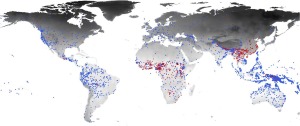
A new report published in the Proceedings of the National Academy of Sciences of the United States of America links the evolution of tonal languages to climate, specifically to heat and humidity. The report, “Climate, Vocal Folds, and Tonal Languages: Connecting the Physiological and Geographic Dots,” is the collaboration of linguists hailing from the U.S., Germany, and the Netherlands, and builds off of previous research that correlated the physiology of vocal folds in the larynx, also known as the voice box, to ambient air conditions; more hydrated vocal folds are able have a more robust amplitude for vibration, and therefore effects the speaker’s ability to produce certain sounds. Previous studies have also noted that inhaling dry air affects vocal folds, as it dries out mucous membranes. This study predicts that climatic factors can hinder the use of phonemic tone, and that humid and hot climates would have been more hospitable to the evolution of tonal languages over time.






